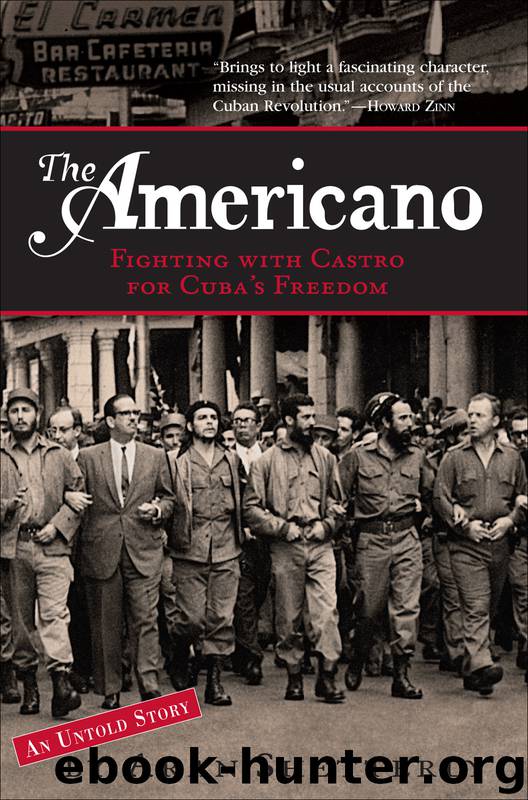The Americano by Aran Shetterly

Author:Aran Shetterly
Language: eng
Format: epub
Publisher: Algonquin Books
Published: 2006-12-31T16:00:00+00:00
CHAOS
The joy most Cubans felt could not mask the chaos and violence of change. The shift from past to future in Cuba danced along to calls for unity, the roar of airplanes taking off and landing, and the sharp report of rifle shots. Havana’s firemen raced to extinguish blazes set by revenge-minded revelers. Citizens beat the tops off parking meters with hammers and baseball bats and ravaged some of Havana’s fancy nightclubs, symbols of corruption and decadence. It was all happening very fast.
The tectonic shift of political realignment was beginning. Planes flew from Havana to Miami filled to capacity with fleeing passengers while others returned with Cubans who hoped to reclaim what had been theirs.
A few hours after Batista left, an army leader named José Pedraza departed for Ciudad Trujillo (now Santo Domingo) in the Dominican Republic, arriving the morning of January 1. Batista, whom Pedraza called “yellow bellied” for ceding Cuba to the Rebels, was already there. Pedraza immediately began plotting Castro’s demise and his own return.
At approximately the time Pedraza landed in the Dominican Republic, Carlos Prío, the former president who had made his own unceremonious exit when Batista took over the government, arrived in Havana from Miami. He expected to work his way back into a cozy position in the government and renew the graft that had made him and his family rich. Friends and followers greeted him warmly on his arrival.
The 26th of July Comandantes Che Guevara and Camilo Cienfuegos, under explicit orders from Castro to seize two strategic military sites, left Las Villas for Havana shortly after the Rebel victory. Che took over the military barracks at La Cabaña, and Camilo took control of the military headquarters at Camp Columbia. The transition of military authority went relatively smoothly.
By January 2 the atmosphere in the capital was calmer as the guerrillas-turned-peacekeepers ensured that citizens spent more time celebrating than destroying the property deserted by the toppled regime. Patrols of SNFE Rebels arriving from Cienfuegos spread around the city to help the 26th of July Movement maintain order. Even the pro-Batista U.S. ambassador, Earl Smith, had to admit as he departed that the Rebels did a remarkable job, under the circumstances.
An American teenager, Jim Hickey, sat on the porch of his house and watched a mob strip the abandoned house of a Batista loyalist next door. They took everything, right down to the doorknobs and the bathroom fixtures. However, from his vantage point he felt no threat. The Rebel soldiers, many no older than he was, kept a close eye on the situation, allowing only specific outlets for the mob energy.
Although it had publicly recognized the Revolutionary government, the United States maintained its schizophrenic mindset. Prior to the victory, within the U.S. government there was disagreement about whether or not to support Batista. Now the debate was over whether or not to back the Revolutionary government. The central question—Is Castro a Communist?—was a vestige of the name-calling tactics Batista and his allies had used to curry U.S. support.
Download
This site does not store any files on its server. We only index and link to content provided by other sites. Please contact the content providers to delete copyright contents if any and email us, we'll remove relevant links or contents immediately.
| Military | Political |
| Presidents & Heads of State | Religious |
| Rich & Famous | Royalty |
| Social Activists |
Waking Up in Heaven: A True Story of Brokenness, Heaven, and Life Again by McVea Crystal & Tresniowski Alex(37678)
Empire of the Sikhs by Patwant Singh(22981)
We're Going to Need More Wine by Gabrielle Union(18973)
Hans Sturm: A Soldier's Odyssey on the Eastern Front by Gordon Williamson(18491)
Leonardo da Vinci by Walter Isaacson(13190)
The Radium Girls by Kate Moore(11935)
Tools of Titans by Timothy Ferriss(8228)
Educated by Tara Westover(7948)
How to Be a Bawse: A Guide to Conquering Life by Lilly Singh(7396)
Permanent Record by Edward Snowden(5749)
The Last Black Unicorn by Tiffany Haddish(5561)
The Rise and Fall of Senator Joe McCarthy by James Cross Giblin(5233)
Promise Me, Dad by Joe Biden(5090)
The Wind in My Hair by Masih Alinejad(5036)
A Higher Loyalty: Truth, Lies, and Leadership by James Comey(4851)
The Crown by Robert Lacey(4732)
The Iron Duke by The Iron Duke(4294)
Joan of Arc by Mary Gordon(4023)
Stalin by Stephen Kotkin(3885)
